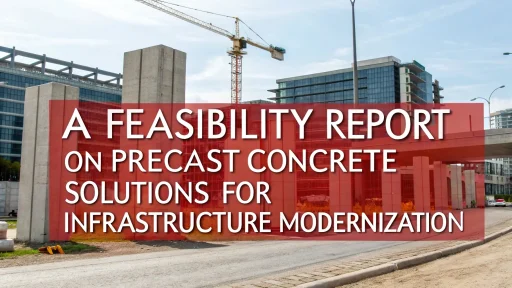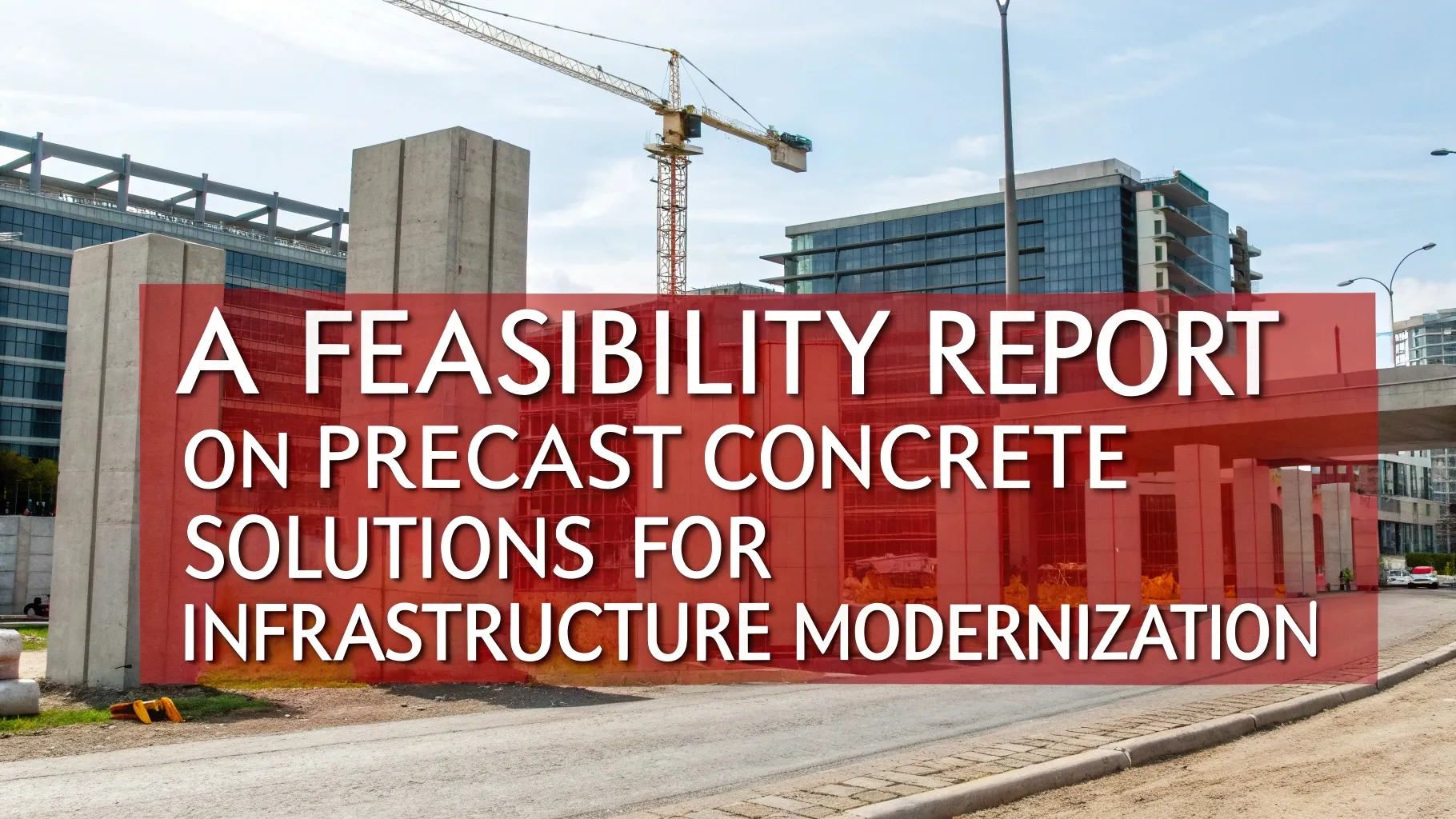Why Speed Now Defines Success in Indian Infrastructure
India is going through a radical change in terms of infrastructure development. Construction of expressways, modern airports, metro rail services, smart cities, and even affordable housing is going on in full scale. The timelines and scale of these projects are forcing the industry to evolve its business model on construction. This is where the use of Precast Concrete Solutions components comes in handy.
Rather than opting for cast-in-situ methods, structural components such as beams, slabs, walls, columns, and girders can be manufactured off site in factories and transported to the construction site for assembly. This approach reduces construction timelines, labor dependency, and enhances quality and durability of the structure.
There lies an opportunity in establishing precast concrete manufacturing units that can cater to the surge of demand rising from the new construction projects across the country. Such an opportunity would create a strong venture that would serve roads, rail, urban housing, and commercial development projects. With proper feasibility studies, an acquisition strategy, and cement plant design analysis, a precast concrete business holds the potential to become a capital-efficient industrial venture.
The Need for Precast: Meeting Deadlines, Manpower Gaps, and Eco-Friendly Solutions
India’s infrastructure initiatives have hit one paradox during their execution: there is always a tremendous amount of demand available; however, the need for timely and reliable delivery still remains a challenge. Constructions are often weather-dependent and slow; in contrast, precast concrete solutions offer the required speed, dependability, and have modularity to support large scale contracts.
Time sensitivity has increased dramatically in the construction sector. The NHAI, under the Bharatmala Initiative, is undertaking expressway projects at over 30 kilometers a day pace while metro systems are simultaneously being executed in over 15 cities. Such massive constructions require highly modular, repeatable building techniques that require minimal site workers.
Precast concrete systems support functioning as stated above, offering highly modular repeatable construction methods tailored for large-base infrastructure.
- Factory controlled quality compliance of ISO and BIS standards.
- Construction timelines reduction by 40-50%.
- Lower reliance for manpower, critical during labor shortfalls.
- Environmental benefits like reduced dust, water usage, and material waste.
The precast concrete technology is becoming fundamental to modern Indian engineering approaches. This includes boundary walls for logistics parks, segmental girders for metro rail systems, and industrial shed footings and piles.
Related: Why Invest in the Production of Precast RCC Walls?
The Primary Uses Fueling the Need for Precast Concrete
India’s focus on developing new public infrastructure has awakened a previously dormant demand for precast construction. There is now a growing need for and preference to use precast solutions in various project types because of their time and cost efficiency.
1. Road and Highway Projects
Crash barriers, culverts, and parapet walls are often flyovers, bridges, and underpasses. These structures make use of U-girders and box segments precast. Also, the use of segmental precast construction in bridge deck or pier construction is very helpful in reducing traffic disruption and construction delays.
2. Urban Transport and Metro Rail
Precast construction is being used in all the major metro systems, and also in Delhi and Mumbai, Pune, and Kanpur. They all use precast segmental box girders, staircases, slabs, pier caps, and station walls. These urban components are produced off-site and assembled at the location with launching girders, so there is no need to block busy streets.
3. Affordable and Mass Housing
With programs like PMAY and EWS/LIG housing at a state level coupled with schemes at the government level, the goal is to deliver thousands of units quickly. Assembly turned out to be possible because precast panels for walls, staircases, and floor slabs of entire buildings turned out within weeks instead of months.
4. Commercial Areas, Industrial and Warehousing Sectors
Schools and hospitals, as well as logistics parks and factories, can all make use of precast structures. These buildings help developers meet stringent timelines while also ensuring uniformity. A new trend in industrial real estate is PEB-integrated hybrid precast buildings.
India’s Market Potential for Precast Concrete Solutions
Although India’s precast market is still in its infancy, it is expected to pick up pace sharply over the next five years. This is likely due to a combination of favorable policy frameworks, the execution of public and private sector projects, and plans for urbanization.
Here’s a 5-year outlook on India’s precast concrete market:
| Year | Projected Market Size (INR Cr) | Main Drivers |
| 2025 | ₹9,800 | Metro rail, urban infrastructure, flyover construction |
| 2026 | ₹12,000 | Development of smart cities, warehousing, industrial zones |
| 2027 | ₹14,700 | Housing boards, SEZs, port-linked logistics hubs |
| 2028 | ₹17,900 | Mass housing initiatives under PMAY, acceleration of green buildings |
| 2029 | ₹21,200 | Adoption by private investors in tier-2/3 metro cities |
Furthermore, increased return on investment (RoI) in engineering, procurement, and construction (EPC) projects is fueling this growth. A faster return on investment benefits revenue generation, payment release, and revenue commissioning.
A Brief Look at the Manufacturing Process of Precast Concrete Units
A precast concrete unit is not simply a concrete mixing area. It is an industrial park with partitions for the batching, curing, quality control, and casting areas. Its repeatability and scale is its efficiency.
The basic steps within the production process are:
- Design and Mold Making: Custom molds from aluminum or steel are made for precast components as per project requirements.
- Rebar and Reinforcement Setup: Precast components are prepared by designing steel cages based on structural loads.
- Mixing and Pouring: Concrete mix designs from batch plants are poured into molds, with freshly mixed concrete delivered by truck.
- Curing Systems: Strength and surface finish is obtained through steam water curing in temperature regulated controlled environments.
- Finishing, Storage, and Dispatch: Components are demolded and stored. They are then transported to the site through cranes.
Quality control is essential in all the aforementioned steps especially for compressive strength, radius of action, surface finish and bonding strength. For value-enhanced precasts such as thermal insulated panels and utility embedded slabs alongside precise engineering, quality becomes a differentiating factor.
Related: How to start Manufacturing Business of Ferro Cement Plant
Important Factors in Establishing a Precast Concrete Plant
The success of a venture in precast hinges on demand as well as location, plant layout, raw material accessibility, and the plant’s level of automation. A site within active infrastructure zones like Delhi-NCR, the Gujarat Industrial Corridor, or the urban clusters of Maharashtra speeds up client access and lowers logistics costs.
A typical plant setup consists of:
- Batching and mixing units with high-accuracy controls
- Moulding stations for different component types
- Pre-stressing beds (for structural elements like girders)
- Curing chambers with steam/heat options
- Gantry cranes and peripheral storage yards and logistics handling areas
- Utilities like power and water along with raw material storage (cement, aggregates, and steel) must be incorporated into the design of the plant
Other than that, operational plans include matters such as training the workforce, safety compliance, and environmental management (dust control and wastewater recycling).
At this stage, it is necessary to draft a Techno-Economic Feasibility Report (TEFR) to define the plant capacity, equipment requirement, workforce cost, and projected output alongside nearby project demand.
Why a Bankable Feasibility Report is Essential for Project Execution
Estimates and informal budgets will not work for precast manufacturing. Funding for the project comes in from EPC contractors, financial institutions, or private investors. They require clear evidence of project viability, return on investment, and scalability. This is exactly where the Techno-Economic Feasibility Report (TEFR) becomes handy.
A TEFR focuses on:
- Estimating and mapping sectoral demand and regional demand
- Planning production, product mix, and plant scale
- Costing vendors and their machinery
- Acquisition of utilities such as land, power, electricity, and others
- Planning of the workforce, logistics, regulatory requirements, and compliance
- Timeline profitability and breakeven analysis, cost analysis, IRR and more
For entrepreneurs seeking loans from SIDBI or State Financial Corporations, TEFR serves as validation for the proposal. It also serves as the basis for JV discussions with infra construction firms or government bodies.
For more information check out this video
How NPCS Supports Precast Business Ventures with Planning and Feasibility
Niir Project Consultancy Services (NPCS) specializes in helping entrepreneurs, developers, and EPC contractors evaluate and plan precast ventures with end-to-end feasibility documentation. Their Market Survey cum Detailed Techno-Economic Feasibility Reports are tailored to project scale, location, demand, and product mix.
NPCS provides:
- Regional demand and project pipeline analysis
- Machinery layout and component capacity planning
- Raw material logistics and utility mapping
- Cash flow, IRR, ROI modeling for funding readiness
- Compliance checklists and factory layout optimization
With NPCS’s expertise, entrepreneurs can make informed decisions about where to set up, what to manufacture, and how to price and market their services in a B2B-driven infrastructure ecosystem.
Conclusion: The Future of Fast Infrastructure Is Precast—and It’s Bankable
Speed is no longer a luxury in Indian infrastructure—it is an imperative. Precast concrete solutions offer an unbeatable combination of speed, safety, consistency, and scalability. But the opportunity goes beyond engineering—it is a business model waiting for execution.
For entrepreneurs, now is the time to explore this market—not just as product manufacturers but as service partners in India’s infrastructure story. With the right planning, modern technology, and a strong feasibility roadmap, a precast unit can become a high-margin, high-volume business.
The first step? Get a professional feasibility study done—one that aligns with your vision and the industry’s direction.
Looking to build your precast project?
Niir Project Consultancy Services (NPCS) provides:
- Feasibility reports for setting up Precast Concrete Solutions units aligned with Indian infra demand
- Detailed project layouts, manufacturing process mapping, and raw material analysis
- Financial modeling and investor-ready documents to support capital mobilization
Let NPCS help you build faster, smarter, and stronger.







